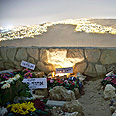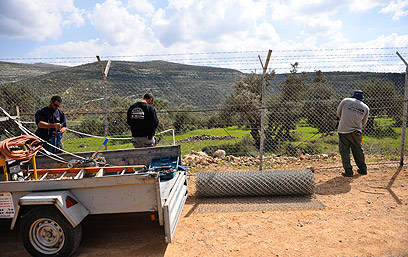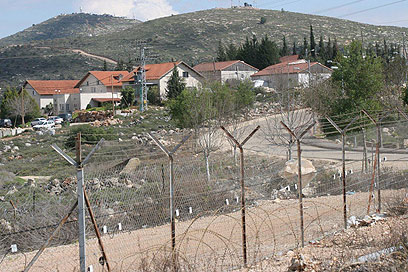
Itamar's security fiasco
On night of Itamar attack, alarm goes off eight times indicating security fence was breached. Undertrained, unequipped guard who responds on scene finds nothing. Could Fogel family massacre have been prevented?
Friday night, March 11, 2011. The alarm system of the electronic fence surrounding the West Bank outpost of Itamar goes off at exactly 8:59 pm.
Over the next three minutes, seven more warning messages register on the computer screen in the settlement's operation room, indicating that someone might be trying to breach section 20 of the fence. A security officer scours the specified area, but does not find anything unusual.
Things return to normal, with the approval of the settlement's security coordinator, who does not arrive on the scene. No military force is alerted.
That same night, five members of the Fogel family are stabbed to death.
No one sees the terrorists slip in or out of Itamar. They walk around town undisturbed for over two hours.

Itamar Security Fence (Photo: Ben Klemer)
'IDF knew it's a dead spot'
Itamar is protected by guards provided by a private company, Nof Yam Security. The town's security coordinator, an IDF subordinate, is in charge of these guards. On the night of the attack, guard Yuri Antropov was securing the settlement, answering to coordinator Matanya Ben-Shitrit.
The infiltration took place at a blind spot, hidden by trees and unseen by the town's security cameras. "The area wasn't exposed because the Civil Administration objected," an element of the Samaria defense establishment said. "The IDF knows very well that it is a dead spot. I didn't ask for exposure because it wasn't something achievable." Only after the attack was the area cleared of trees.
If section 20 of the fence was under surveillance, the terrorists could have been identified. But Ben-Shitrit, the security coordinator, said that a camera was not installed because there was no one to finance it. "If the IDF agreed to install a camera here, it would have been here a long time ago," he said.
Moreover, the security guard, who arrived on the scene minutes after the alarm went off, surveyed the area using only his vehicle's head lights. He did not carry a searchlight or night vision equipment; he did not even have a flashlight with him.
According to the defense establishment element, the settlement and the regional council were supposed to equip the guards with flashlights and searchlights, while the army is supposed to provide the night vision devices.
"I asked for these tools but was refused," Ben-Shitrit said. "Now the patrol cars have the necessary tools. Everyone wakes up after an attack."

Itamar security fence (Photo: George Ginsburg)
After scanning the fence segment twice, the guard reported to Ben-Shitrit that he did not find anything out of the ordinary. The security coordinator, who was home, told him to return to routine activity without visiting the area in person. The investigators concluded that the terrorist were already in Itamar at that time.
"According to the rules, the person who had to search the spot was the patrolman, not both of us," Ben-Shitrit explained. "If I or even the IDF chief of staff arrived on the scene, we would not have been able to find the breach. Even the company commander admitted that he couldn't locate it, and said that if we sent for him he wouldn't have come."
Antropov, the guard, seconded his superior's claims. "Even the trackers, who arrived there at night, after the attack was reported, couldn't find anything," he said. "Only the following day they noticed that the fence was bent upwards, which can indicate an infiltration point. It's impossible to call a break-in only because the fence was touched."
10 seconds is all it takes
The "smart" fence surrounding the settlement was designed to identify movements caused by touch, cutting or shaking. The computer screen registers the time of the breach, the time that the alarm was turned off by the guard, and the time that the breach was terminated.
"This case did not seem suspicious because animals sometimes touch or collide with the fence for many minutes," Antropov said.
"It was irrelevant because it was a routine occurrence," Ben-Shitrit added. "There can be a shift with 200 fence collisions caused by animals."
But a security source claimed that if the guard was properly trained, he would have realized that it wasn't an animal rocking the fence.
While the fence does not differentiate between animal and human touch, the length of the alarms should have raised suspicion. Out of the eight warning messages that registered on the screen that evening, the longest one lasted 18 seconds.
"According to a test done after the terrorist attack, it takes 10 seconds on average to get through the fence," Antropov said. "A fat tracker got past the fence with a jump, and there was a shock that lasted maybe a few seconds."
Antropov noted that he and his fellow guards did not train extensively on the fence system.
"We were ordered to treat each warning in the dead spot in the same manner, regardless of how long it lasted, by sending a patrolman out," he said. "Only after the attack did the technician explain to us the different lengths."
Procedure changed after attack
An IDF element said that Itamar's security procedure was written by the security coordinator and an IDF regional defense officer, and signed by a brigade commander. The security coordinator was trained on the procedure by IDF officers.
"I did not see any security procedure file before the attack," Antropov said. "Now it's in the operation room."
Furthermore, before the attack it was unclear who is supposed to sign off after a false alarm sounds; the guards would notify the security coordinator, then things would return to normal. The procedure changed after the attack, requiring an IDF brigade to patrol the area of the breach if no sign of an animal is found. A brigade commander or deputy commander must sign off before routine activity is resumed.
According to a Samaria security element, the IDF usually is not dispatched in response to shocks to the fence. "While the patrol unit is notified in most cases, there were so many warning messages lately that it stopped responding to them," he said.
From 11:09 pm to 11:11 pm, another string of five warning messages registered in the Itamar operation room. Some of the messages lasted almost 30 seconds. A patrolman searched the fence, again not finding anything. The guards returned to normal, this time not notifying the security coordinator. In retrospect, it was found that at that time the killers climbed the fence on their way out. The Fogel family members were already dead.
An IDF spokesman said in response that the army is looking into the incident, and the findings of the inquiry, which should be presented before the Central Command chief and the IDF chief of staff in the coming days, will be studied and internalized. He also noted that the fence is responsibility of the regional council.
"Itamar's fence is one of the best in the world, and the defense establishment approved it," said Eitan Livne, the president and CEO of Magal Security Systems, which manufactured the fence's sensors. "It fulfils the strict criteria of few false alarms and high chances of registering true warnings."
- Follow Ynetnews on Facebook










